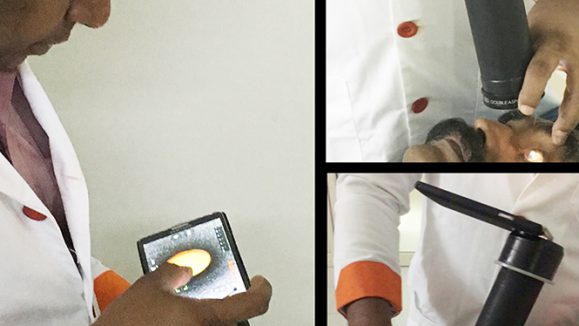Renowned retina specialists gathered at the 23rd EURETINA Congress in Amsterdam to explore novel approaches to age-related macular degeneration (AMD), a leading cause of blindness in individuals over 55. Presentations delved into the challenges of current treatments, such as the lifelong burden of frequent injections, prompting a quest for alternatives. The Congress highlighted promising strides, including insights into geographic atrophy differences among ethnic groups, advancements in gene therapies and emerging trials offering hope for reduced treatment burdens.
At present, treatments for age- related macular degeneration (AMD) and neovascular AMD (nAMD) require life-long, frequent injections to maintain efficacy, which poses a significant treatment burden for patients and often results in reduced compliance and undertreatment—leading to potentially limited outcomes.
On the final day of the 23rd European Society of Retina Specialists Congress (EURETINA 2023), retina specialists from around the world gathered at the RAI Amsterdam Convention Centre in the capital city of the Netherlands to share some of the latest research findings—ranging from gene therapies, combination treatments and more. This was part of efforts to seek alternatives to frequent injections, aiming to help patients preserve their vision.
Here are some snippets from the session.
Ethnicity’s impact on GA growth
According to Prof. Gemmy Cheung, the Arthur Lim Professor in Ophthalmology at the Duke-National University of Singapore Medical School, National University of Singapore, while epidemiological data suggests that geographic atrophy (GA) is rare among Asians, there are differences in phenotypes and growth rates between Asians and non-Asians.
A multicenter retrospective study carried out by Prof. Cheung and colleagues from the Asia-Pacific Ocular Imaging Society (APOIS) that compared Asian and non-Asian patients found specific differences between the ethnic groups in GA lesion phenotypes, associated features and growth rates.
“Ethnicity was by far the factor that had the biggest effect on determining the growth rate,” she said. Participants included in the study were over 50 years old with GA secondary to age-related macular degeneration and had been followed for two years or longer.
A total of 144 patients (169 eyes) were included. Her takeaway messages include the following: The differences in GA phenotypes in Asians compared to non-Asians were smaller lesion areas, fewer foci and less bilateral cases. Asians were also associated with a thicker choroid and fewer drusen. Ethnicity was the biggest factor associated with the growth rate of GA: It was slower in Asians compared to non-Asians. Subgroups with drusen and larger baseline lesion area showed less difference between faster progression in Asians and non- Asians.

An OASIS of hope
Promising results are being seen in a number of trials of emerging therapies for exudative AMD, according to a presentation by Dr. Arshad M. Khanani, director of clinical research at Sierra Eye Associates, and clinical associate professor at the University of Nevada, Reno School of Medicine, USA.
The OPT-302 trial showed positive results in the phase 2 study, where patients with nAMD who were treated with ranibizumab plus sozinibercept (OPT-302) had greater gains in visual acuity compared to those treated with ranibizumab alone.
Superior vision gains were seen at week 24 with sozinibercept 2mg combination therapy, said Dr. Khanani. There was also improved visual acuity in patients with occult- containing lesions.
Meanwhile, subretinal gene therapy with RGX-314 continues to be generally well-tolerated in a long-term follow-up study and will continue to be followed for a total of five years. “With a single injection of ABBV- RGX-314, patients demonstrate a long-term, durable treatment effect for Cohort 3 over four years and Cohort 4 over three years,” he said.
ABBV-RGX-314-treated patients had stable vision and retinal thickness with a meaningful reduction in treatment burden across all dose levels. There was an 85% reduction in the annualized injection rate.
Intravitreal gene therapies are also being trialed involving ADVM- 022 for the continuous delivery of aflibercept, as well as 4D-150 for the continuous delivery of aflibercept and VEGF-C RNAI.
Interim results from the PRISM trial showed that intravitreal administration of 4D-150 to adults with wet AMD was safe and generally well-tolerated with no inflammation in 14 of 15 patients.
There were no dose-limiting toxicities, treatment-related serious adverse events, or hypotony reported. There was stable best corrected visual acuity (BCVA) and central subfield thickness (CST) through week 36. Enrollment for the Phase 2 dose expansion stage of the PRISM trial (n=50 patients) has been completed.
In addition, tyrosine kinase inhibitors (TKIs) are also being studied in clinical trials, namely OTX-TKI, EYP- 1901 and CLS-AX.
Dr. Khanani continued, stating that the 12-month results from a Phase 1 trial support the advancement of the OTX-TKI axitinib intravitreal implant that is being developed for the treatment of diabetic retinopathy and other retinal diseases, including pivotal trials in nAMD.
It maintained vision and CST comparable to aflibercept 2mg at 8 week treatment intervals, with an 89% reduction in treatment burden over a 12-month period with 605 of patients being rescue-free up to 12 months. Safety data showed it was generally well-tolerated.
Implant bioresorption and axitinib elution were consistent with previous clinical data, potentially allowing a window for redosing, Dr. Khanani added.
Pharmacodynamic effects observed in this trial support the characteristics of a potential treatment for nAMD, with durability between nine to 12 months with a single injection. OTS-TKI pivotal trials innAMD will be initiated soon.
The safety and preliminary efficacy of EYP-1901, a novel intravitreal injection therapy consisting of vorolanib, a small molecule pan-VEGF receptor blocker, as a maintenance therapy in patients with previously treated nAMD were investigated in the Phase 1 DAVIO trial. It found that there was a 73% reduction in treatment burden at 12 months. Results for phase 2 of the trial will be out in Q4 2023.
The use of CLS-AX (axitinib injectable suspension) for suprachoroidal use may improve the treatment landscape with potential safety, efficacy, durability and adoption benefits, Dr. Khanani said.
Compartmentalization may eliminate symptomatic floaters and anterior segment side effects. It had no dose- limiting toxicities and exhibited early signs of durability and reduction in treatment burden.
In the OASIS study, there was a 72% reduction in treatment burden over the first three months. In its extension study through 6 months, there was a 77% reduction in treatment burden. CLS-AX is currently being evaluated in the ODYSSEY Phase 2b clinical trial.
Editor’s Note:
- The 23rd Annual EURETINA Congress took place on October 5 to 8, 2023, in RAI Amsterdam Convention Centre, Amsterdam, The Netherlands. Reporting for this story took place during the event.
- A version of this article was first published in PIE Magazine Issue 28.
![shutterstock_2328369243 [Converted] 01](https://piemagazine.org/wp-content/uploads/sites/4/2023/12/shutterstock_2328369243-Converted-01-1.png)


